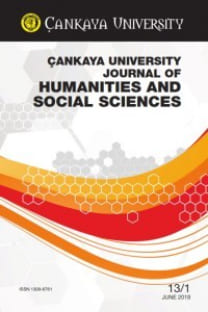Honaz Dağı Milli Parkı'nda (Denizli) Toprak Akarlarının (Acarı) Dikey Dağılımı
Toprak Akarlar›, Dikey Dağ›l›m, Honaz Dağ›, Türkiye.
Honaz Dağı Milli Parkı'nda (Denizli) Toprak Akarlarının (Acarı) Dikey Dağılımı
-,
___
- A.I.M. Al-Assiuty, B.M. Bayoumi, M.A. Khalil, N.M. Van Straalen, “The influence of vegetational type on seasonal abudance and species composition of soil fauna at different localities in Egypt”, Pedobiologia 37 (1993), pp. 210-222.
- N. Ayyıldız, “Erzurum Ovası Oribatidlerinin (Acari) Bitki Örtüsü ve Toprak Yapısıyla İlişkileri, Türkiye I. Etnomoloji Kongresi, 13-16 Ekim 1987, İzmir.
- N. Ayyıldız, K. Koç, “Atatürk Üniversitesi Çam Koruluğunda Toprak Akarlarının (Acari) Dikey Dağılımı Üzerine Bir Çalışma”, XII. Ulusal Biyoloji Kongresi, 6-8 Temmuz 1994, Edirne Zooloji Seksiyonu, 160-166.
- A. Baytop, E. Tuzlacı, “Honaz Dağı Bitkileri I” İst. Ecz. Fak. Mec. 12 (1976), 30-74.
- A.N. Ekiz, R. Urhan. “Honaz Dağı Milli Parkı (Denizli)’nin Toprak Akarları (Acari: Gamasida). Türkiye Dağları I. Ulusal Sempozyumu, Ilgaz Dağı, Kastamonu, 25-27 Haziran 2002, 544-547.
- G.O. Evans, J.G. Sheals, D. Macfarlane, “The Terrestrial Acari of the British Isles. Alden Pres., Oxford, England, vol. 1 (1961), p. 219.
- M.S. Ghilarov, “In Soil Organism I” Doeksen and van der Drift, (eds.), North Holland Publ. Co., Amsterdam (1963, pp. 255-259.
- N. Haarlov, “Microartropods from danish soils: Ecology, Phenology”, Oikos, 3 (1960), pp.1-176.
- J.A. Holt, “The vertical distribution of cryptostigmatic mites, soil organic matter and macroporosity in Three North Queensland Rainforest Soils”, Pedobiologia, 22 (1981), pp. 202-209.
- K. Koç. N. Ayyıldız, “Atatürk Üniversitesi Kampüsü’ndeki Çam Koruluğunda Oribatid Akarların (Acari: Oribatida) Dikey Dağılımı”, Doğa - Tr. J. of Zoology, 16 (1992), 361-384.
- J.W. Leetham, D.G. Milchunas, “The Composition and Distribution of Soil Microarthropods in the Shortgrass Steppe in Relation to Soil Water, Root Biomass, and Grazing by Cattle”, Pedobiologia, 28 (1985), pp. 311-325.
- M. Luxton, “Studies on the Oribatid Mites of a Danish Beechwod Soil. V. Vertical Distribution”, Pedobiologia 21 (1981a), pp. 359-380.
- M. Luxton, “Studies on the Oribatid Mites of a Danish Beechwod Soil. VI. Vertical Distribution”, Pedobiologia 21 (1981b), pp. 387-409.
- J.C. Perdue, D.A. Crossley, “Vertical Distribution of Soil Mites (Acari) in Conventional and No- Tillage Agricultural Systems”, Biology and Fertility of Soils, 9 (1990), pp. 135-138.
- D.W. Price, “Abudance and Vertical Distribution of Microartropods in the Surface Layers of a California Pine Forest Soil”, Hilgardia, 42 (4) (1973), pp. 121-148.
- R. Urhan, “New Zerconid Mites (Acari, Gamasida, Zerconidae) from Turkey”, J. Nat. Hist., 36 (2002). pp. 2127-2138.
- M.B. Usher, “Seasonal and Vertical Distribution of Soil Arthropods: Mesostigmata”, Pedobiologia, 11 (1971), pp. 27-39.
- M.B. Usher, “Seasonal and Vertical Distribution of Soil Arthropods: Cryptostigmata”, Pedobiologia, 15 (1975), pp. 364-374.
- ISSN: 1309-6761
- Yayın Aralığı: Yılda 2 Sayı
- Başlangıç: 2004
- Yayıncı: Çankaya Üniversitesi
Ethical Aesthetics /Aesthetic Ethics: The Case of Bakhtin
Complexity Metrics AS Predictors of Maintainability and Integrability of Software components
Yabancı Dil Öğretim ve Öğreniminde Eski ve Yeni Yöntemlere Yeni Bir Bakış
Türkische FolkloreTexte aus Chorasan
On Basis Property for a Boundary-Value Problem with a Spectral Parameter in the Boundary Condition
Vagif Y. Gul, Khanlar R. MAMEDOV, Khanlar R. MAMEDOV
Optical Absorption in Polycrystalline CdTe Thin Films
Bengül Zengir, Murat Bayhan, Sertap KAVASOĞLU
An Inequality of Fejer-Riesz Type
Senecan Drama and Its Influence on The Spanish Tragedy and The Revenger’s Tragedy
Honaz Dağı Milli Parkı'nda (Denizli) Toprak Akarlarının (Acarı) Dikey Dağılımı
Ayşe Öksüz Kahveci, Raşit Urhan, Yusuf KATILMIŞ, Ayşe ÖKSÜZ KAHVECİ, Raşit URHAN, Yusuf KATILMIŞ
